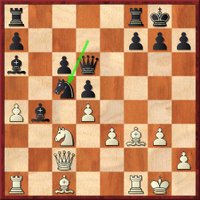Bourne, B Vs Grange, J
1)c4 e5 2)Nc3 Bb4!? The Kramnik-Shirov counter-attack! An interesting defence to the English which I have had good results with. Sometimes Black will chop on c3 and get a position akin to the nimzo. Either way I find Black gets good activity compared to some other lines. 3)g3 d6 4)Bg2 Nc6 5)e4 this is theory, but I am always happy to see this as the d4 square becomes very sensitive. 5)...Nf6 6)Nge2 Bg4!?
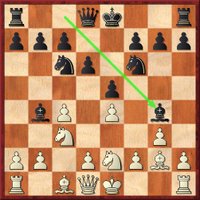
My plan here was to try and reduce whites control over d4, aiming for ...Nd4 myself exchanging some pieces off. Any attempt to eject the Bishop weakens the King slightly or entombs the Bishop. 7)f3 Be6 The Bishop on g2 is temporarily entombed: a theme we shall return to! 8)d3 Nd4? Novelty
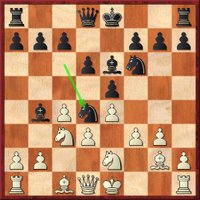 Not all novelties are worthy of an appearance in Infomator! This is a bad blunder. I was transfixed by the weakness of d4 and the inability for White to take my knight on d4 [as 9)Nxd4 exd4 wins the pinned piece - or so I though, see next note] 9)Bc5!? was much better taking more control of the important d4 sqaure. 9)O-O? It was only after white made this move that I saw he could have won a pawn with 9)Nxd4! exd4 10)Qa4+! Nd7 11)Qxb4 dxc3 12)Qxc3 +- where White has a won game. This shows an important rule I all too often forget: "When decided on a move, look at all your opponents possible checks, captures and threats". I feel I could be playing 50pts above what I am [if not more!] if I applied this logic. 9)...Nxe2+ 10)Qxe2 Bc5+ This move removes another defender of d4, as allowing the Black bishop to stay on the a7-g1 diagonal would have caused White too much of a headache! 11)Be3 Bxe3 12)Qxe3 Qd7 keeping my options open as I had not yet decided which side would be safer to castle to 13)b4!? White is obviously determined for me to go Kingside, and who am I to disagree? 13)...O-O 14)Nd5?
Not all novelties are worthy of an appearance in Infomator! This is a bad blunder. I was transfixed by the weakness of d4 and the inability for White to take my knight on d4 [as 9)Nxd4 exd4 wins the pinned piece - or so I though, see next note] 9)Bc5!? was much better taking more control of the important d4 sqaure. 9)O-O? It was only after white made this move that I saw he could have won a pawn with 9)Nxd4! exd4 10)Qa4+! Nd7 11)Qxb4 dxc3 12)Qxc3 +- where White has a won game. This shows an important rule I all too often forget: "When decided on a move, look at all your opponents possible checks, captures and threats". I feel I could be playing 50pts above what I am [if not more!] if I applied this logic. 9)...Nxe2+ 10)Qxe2 Bc5+ This move removes another defender of d4, as allowing the Black bishop to stay on the a7-g1 diagonal would have caused White too much of a headache! 11)Be3 Bxe3 12)Qxe3 Qd7 keeping my options open as I had not yet decided which side would be safer to castle to 13)b4!? White is obviously determined for me to go Kingside, and who am I to disagree? 13)...O-O 14)Nd5?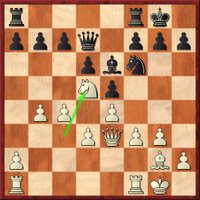
To me though this move was a big mistake. Any fans of Jeremy Silman out there? If there are, you may notice that I am now able to create a favourable minor-piece imbalance, namely superior knight over poor Bishop. I sat and thought this over for about 15 minutes, trying to work out which would be the better piece. Initially it seems obvious that the Black knight will be superior due to the closed nature of the position. But can white open the position? Also Black does not have a permanent home for his knight as d4 is unreachable after a capture on d5. After deep [well, as deep as I can go] contemplation, I decided that the Black Knight would indeed be the better piece. 14)...Bxd5! 15)cxd5 I felth that exd5 would leave more chance of opening up the position, but looking at it now it doesnt seem to make much difference. 15)...c6! At first it seems that black should not be opening up ANY of the position, but I am desparately trying to find a permanent home for my knight. By creating a string centre, I felt I would be able to play a quick ...d5 followed by d4 completely closing the position. 16)dxc6 bxc6 17)f4
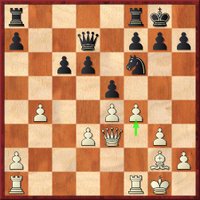 white is trying to open up the position for his Boshop, and will have the better game if I allow this. I have created a favourable imbalance - knight vs bishop, and therefore wanted to keep the position as closed as possible. I recalled a game in Kotov's "Think like a Grandmaster" involving a pawn sacrifice to bottle-up enemy pieces and to create room for his own. Here is the position:
white is trying to open up the position for his Boshop, and will have the better game if I allow this. I have created a favourable imbalance - knight vs bishop, and therefore wanted to keep the position as closed as possible. I recalled a game in Kotov's "Think like a Grandmaster" involving a pawn sacrifice to bottle-up enemy pieces and to create room for his own. Here is the position: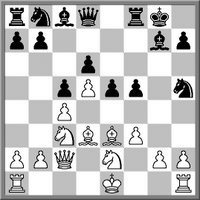 Kptpv was black and played the amazing 1)...e4!! 2)fxef f4! - this last move being the point. He sacrificed a pawn to bottle in the light bishop, and to create room for his own pieces [note the increased activity of the Bg7 and possible use of thr e5 square].
Kptpv was black and played the amazing 1)...e4!! 2)fxef f4! - this last move being the point. He sacrificed a pawn to bottle in the light bishop, and to create room for his own pieces [note the increased activity of the Bg7 and possible use of thr e5 square].Back to my game - I played in similar vain 17)...d5! 18)fxe5 d4! White must react as his Queen is threatened.
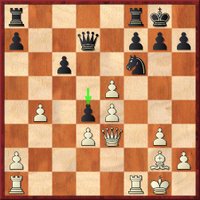 The move has bottled up the Bishop on g2, closed the centre [permanently!] and created a great home on c3 or e3 [also permanent!] for my knight. Not bad for just a pawn! 19)Qg5 Qg4?! trying to trade Queens off, but White doesnt have to play 20)Qc1 Much better than 20)Qxg4? Nxg4 when the knight is going to e3 for good, although the position remains unclear. 20)...Nd7 21)Qxc6 Nxe5
The move has bottled up the Bishop on g2, closed the centre [permanently!] and created a great home on c3 or e3 [also permanent!] for my knight. Not bad for just a pawn! 19)Qg5 Qg4?! trying to trade Queens off, but White doesnt have to play 20)Qc1 Much better than 20)Qxg4? Nxg4 when the knight is going to e3 for good, although the position remains unclear. 20)...Nd7 21)Qxc6 Nxe5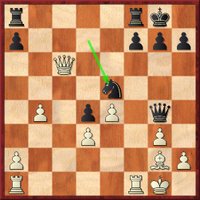 This diagram demonstrates what Black has achieved. Although a clear pawn down with no definite way to reclaim it, I still nonetheless like Blacks position. If black can reach e3 it will be just winning. 22)Qb5 Qe6 23)Rf5 Ng4! here we go!! 24)Bh3 Ne3! There is no useful discovery against the Black Queen 25)Rh5 Qf6
This diagram demonstrates what Black has achieved. Although a clear pawn down with no definite way to reclaim it, I still nonetheless like Blacks position. If black can reach e3 it will be just winning. 22)Qb5 Qe6 23)Rf5 Ng4! here we go!! 24)Bh3 Ne3! There is no useful discovery against the Black Queen 25)Rh5 Qf6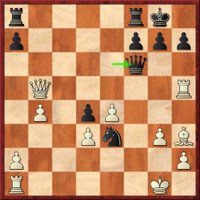 Black enjoys the fruits of his labour - the knight reaches its dream square. Blacks plan is now complete, almost 10 moves later! Once you have an imbalance, you must do EVERYTHING to make it favourable to you. Now black just needs his Rooks to join the party and he will have a very comfortable game. 26)Rc1 Rab8 with tempo! 27)Qc5 a6 28)a3?? Rb5! winning the Rook. White resigned.
Black enjoys the fruits of his labour - the knight reaches its dream square. Blacks plan is now complete, almost 10 moves later! Once you have an imbalance, you must do EVERYTHING to make it favourable to you. Now black just needs his Rooks to join the party and he will have a very comfortable game. 26)Rc1 Rab8 with tempo! 27)Qc5 a6 28)a3?? Rb5! winning the Rook. White resigned.



